National Emblem of the People's Republic of China
The National Emblem of the People's Republic of China contains in a red circle a representation of Tiananmen Gate, the entrance gate to the Forbidden City, where Mao declared the foundation of the People's Republic of China (PRC) in 1949. Above this representation are the five stars found on the national flag. The largest star represents the Communist Party of China, while the four smaller stars represent the four social classes as defined in Maoism. The emblem is described as being "composed of patterns of the national flag":[1]
...The red color of the flag symbolizes revolution and the yellow color of the stars the golden brilliant rays radiating from the vast red land. The design of four smaller stars surrounding a bigger one signifies the unity of the Chinese people under the leadership of the Communist Party of China (CPC)
—China Yearbook 2004[2]
| National Emblem of the People's Republic of China | |
|---|---|
.svg.png) | |
| Armiger | People's Republic of China |
| Adopted | September 20, 1950 |
| National Emblem of the People's Republic of China | |||||||
|---|---|---|---|---|---|---|---|
| Traditional Chinese | 中華人民共和國國徽 | ||||||
| Simplified Chinese | 中华人民共和国国徽 | ||||||
| |||||||
The outer border of the red circle shows sheaves of wheat and the inner sheaves of rice, which together represent agricultural workers. At the center of the bottom portion of the border is a cog-wheel that represents industrial workers.
According to The Description of the National Emblem of the People's Republic of China (中华人民共和国国徽图案说明), these elements taken together symbolise the revolutionary struggles of the Chinese people since the May Fourth Movement and the coalition of the proletariat which succeeded in founding the People's Republic of China.
History
_logo.svg.png)
On July 10, 1949 the government held a public competition for the design of the national emblem, however no satisfactory designs were selected. Therefore, on September 27, 1949, the First Plenary Session of CPPCC decided to invite designers for the proposals of the national emblem and two groups from two universities were selected in September 1949. Three proposals were selected for the first round discussion:
- The designers from China Central Academy of Fine Arts, Zhang Ding, Zhang Guangyu, Zhou Lingzhao and Zhong Ling, handed out their proposals with 5 variations on September 25, 1949. The symbolism of their first design was: The red star symbolizes Communism and the Communist party of China. The cog and wheat/rice symbolizes unification of industrial workers and peasants. The rising earth with China in red symbolizes the socialist revolution in China and the world revolution ideal on Asian counties. 31 rays behind the earth symbolizes the 31 provincial administrative divisions at that time. The name of the People's Republic of China is written on the red ribbon below.[3] The design was based on their design of the emblem of Chinese People's Political Consultative Conference, and was influenced by Socialist heraldry of the Eastern Bloc.
- The designers from the Department of Architecture at Tsinghua University, Liang Sicheng, Lin Huiyin, Mo Zongjiang, Zhu Changzhong, Li Zongjin and Gao Zhuang, handed their proposal on October 30, 1949. According to their proposal, the design was a mixture of traditional Chinese culture and Maoist New Democratic Revolution ideals. The design imitated the style of mirrors in Han dynasty, symbolizing brightness. The disc was made of jade, a symbol of peace and unity. Decorative carvings on the disc was in Tang dynasty style. The stars from national flag and a cog were placed in the center of the disc, surrounded by wheats, symbolizing unity of working class and socialism. The red ribbon tied a smaller jade ring, symbolising the unification of Chinese people.[4]
- The other proposal by Zhang Ding, Zhang Guangyu, Zhou Lingzhao, was a perspective depiction of Tian'anmen gate.
- First round proposals of the national emblem
 Proposals of China Central Academy of Fine Arts, September 25, 1949
Proposals of China Central Academy of Fine Arts, September 25, 1949 Proposal of Tsinghua University, October 30, 1949
Proposal of Tsinghua University, October 30, 1949

Members of the first CPPCC committee discussed these three proposals on June 10, 1950. The result of the discussion was, the China Central Academy of Fine Arts proposal was too colorful that would be regarded as trademarks, and proposal from Tsinghua University was regarded as bourgeoisie that contains many traditional symbols. The committee suggested two groups to include the Tian'anmen Gate, a symbol of Chinese revolution which is the location of May Fourth Movement and foundation ceremony of the People's Republic of China on October 1, 1949.[5]
Two groups then worked on a second round proposals. The second proposal from Tsinghua University standardized the design of the Tian'anmen Gate on the emblem and selected red and yellow as the main colors.[6] Their proposal was selected and the design was standardized and simplified by Gao Zhuang.[7] This design was officially made the national emblem on 20 September 1950 by the Central People's Government.
- Second round proposals of the national emblem
 Proposal of China Central Academy of Fine Arts
Proposal of China Central Academy of Fine Arts
June 15, 1950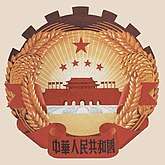 Proposal of China Central Academy of Fine Arts
Proposal of China Central Academy of Fine Arts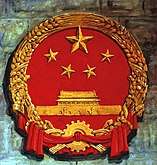 Proposal of Tsinghua University
Proposal of Tsinghua University
June 17, 1950 Proposal of Tsinghua University
Proposal of Tsinghua University Proposal of Tsinghua University
Proposal of Tsinghua University Proposal of Tsinghua University
Proposal of Tsinghua University Proposal of Tsinghua University
Proposal of Tsinghua University
The emblem is also displayed, along with the national flag, at the end of a video clip with the national anthem, March of the Volunteers, regularly played on Chinese television such as state-run China Central Television (CCTV) on a daily basis.
Construction
| Chinese Wikisource has original text related to this article: |
National standard of China: GB 15093-2008 specifies the construction, material and color of the national emblem.
| Proportion | Construction |
|---|---|
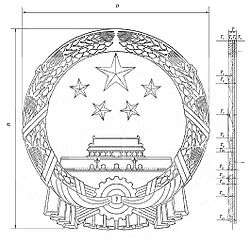 |  |
City Emblems and Special administrative region Emblem
On April 15, 1985, Taiyuan City officially announced its emblem, becoming the first city in the People's Republic of China to have a city emblem.
Hong Kong and Macao each have their own emblem. The National People's Congress have passed the standardized use of the two special administrative regions' emblems.
Under Chinese law since November 1997, only Hong Kong and Macau are allowed to have their own emblems and other localities that had them had to stop using theirs.[8] This rule was ignored in 2011 when the city of Chengdu chose the Golden Sun Bird found under the city's Jinsha site as its emblem.[9]
Historic emblems
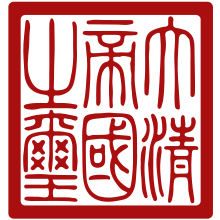 Imperial Seal of the Qing dynasty.
Imperial Seal of the Qing dynasty.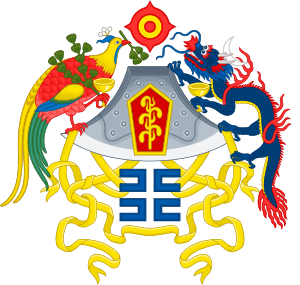
 Blue Sky with a White Sun emblem of the Republic of China (1928–present) and the first emblem of the People's Republic of China (1949–1950)
Blue Sky with a White Sun emblem of the Republic of China (1928–present) and the first emblem of the People's Republic of China (1949–1950) Emblem of the Chinese Soviet Republic (1931–1937)
Emblem of the Chinese Soviet Republic (1931–1937) Imperial Seal of Manchukuo (1932–1945)
Imperial Seal of Manchukuo (1932–1945) Emblem of the National Reorganized Government of the Republic of China (1940–1945)
Emblem of the National Reorganized Government of the Republic of China (1940–1945).svg.png) Emblem of the People's Republic of China (1950–present)
Emblem of the People's Republic of China (1950–present)
References
- Description of the National Emblem from Chinese Government web portal. Archived 2012-05-02 at the Wayback Machine
- National flag Archived 2007-06-04 at the Wayback Machine
- 国徽图案参考资料, Reference on proposals of national emblem, 1949.
- 徐志摩诗文网 Archived 2013-05-14 at the Wayback Machine, 拟制国徽图案说明, Explanation of national emblem proposal
- 到底是谁设计了国徽,新华网
- 正投影 国徽设计中亮丽的一笔 Archived 2013-05-14 at the Wayback Machine
- 高庄:命运多舛的国徽浮雕定型设计者
- 中共中央办公厅、国务院办公厅关于禁止自行制作和使用地方旗、徽的通知 (Chinese Communist Central Governmental Notice to Ban Making and Using Local Flags and Emblems)
- "Chengdu Unveils its New City Logo". news.ifeng.com. 2011-12-30. Retrieved 2012-09-30.
External links




